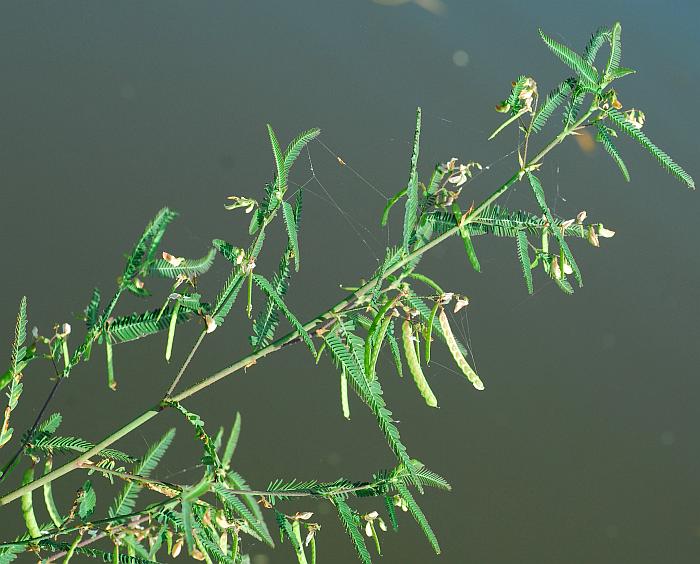Aeschynomene rudis Benth.
Rough Jointvetch

Introduced
CC = *
CW = 5
MOC = 1
© SRTurner
Aeschynomene rudis Benth.Rough Jointvetch | |
 |
Introduced CC = * CW = 5 MOC = 1 |
© SRTurner |
|
Family - Fabaceae/Faboideae Habit - Robust annual forb. Stem - Ascending to erect, to 2 m, sometimes branched, the upper portion moderately pubescent with pustular-based spreading hairs to 2 mm long.
Leaves - Alternate, pinnately even-compound, petiolate, sensitive to light and touch. Stipules conspicuous on young growth but usually shed with age, herbaceous, lanceolate, peltate, with a small lobelike appendage below the point of attachment, 8-10 mm long, 4-5 mm wide, tapered to a sharply pointed tip. Petioles 10-12 mm long, the rachis 9-12 cm long, the petiole and rachis pubescent with pustular-based nonglandular, whitish hairs. Blades with 40-50 leaflets, these subopposite, 8-16 mm long, 2-3 mm wide.
Flower - Peduncles often glandular-hairy and sticky, the bracts subtending the flowers similar to the stipules but often smaller. Calyces with the tube 0.8-1.0 mm long; the upper lip 4-5 mm long, shallowly 2-lobed apically; the lower lip 4-5 mm long, shallowly 3-lobed apically. Corollas papilionaceous, glabrous, yellow to orange, sometimes striped or tinged with red or purple, the petals tapered to a short stalklike base; the banner broadly ovate to nearly circular; the wings narrowly obovate; the keel oblanceolate and curved in outline, boat-shaped. Stamens 10, the filaments all fused, the tube split on 1 side or more commonly deeply on 2 sides into 2 groups of 5 stamens each, the anthers small, attached near the midpoint, all similar in size. Ovary linear, short-stalked, often hairy, the style glabrous, curved, the stigma small and terminal.
Fruits - Fruits 4-6 cm long, 4-6 mm wide, the stalk 4-6 mm long, the surfaces at maturity sparsely pustular- hairy, usually with pronounced medial lines of stout pustular-based, warty projections to 1 mm long, dehiscent into 7-12 segments, these 5-6 mm long, 5-6 mm wide. Seeds 4-5 mm long, 2-3 mm wide, reddish brown to olive brown.
Flowering - July - September. Habitat - Fields, ditches, rice paddies. Origin - Native to South America. Lookalikes - Aeschynomene indica. Other info. - This introduced legume was first reported in Missouri in 1994, and remains rare in the state. Its U.S. range is sparse, consisting principally of widely scattered locations in a few southern states. The plant is somewhat weedy and, since it prefers seasonally flooded areas such as marshes and rice paddies, has the potential to become a problem in rice fields. Photographs taken at Otter Slough Conservation Area, Stoddard County, MO, 9-11-2019 and 8-17-2021 (SRTurner). |